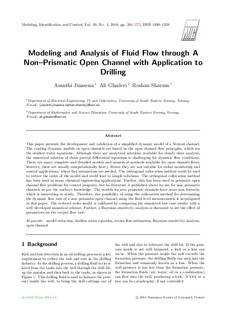| dc.contributor.author | Jinasena, Asanthi | |
| dc.contributor.author | Ghaderi, Ali | |
| dc.contributor.author | Sharma, Roshan | |
| dc.date.accessioned | 2019-02-04T10:17:08Z | |
| dc.date.available | 2019-02-04T10:17:08Z | |
| dc.date.created | 2018-12-01T23:55:50Z | |
| dc.date.issued | 2018 | |
| dc.identifier.citation | Modeling, Identification and Control. 2018, 39 (4), 261-272. | nb_NO |
| dc.identifier.issn | 0332-7353 | |
| dc.identifier.uri | http://hdl.handle.net/11250/2583708 | |
| dc.description.abstract | This paper presents the development and validation of a simplified dynamic model of a Venturi channel. The existing dynamic models on open channels are based on the open channel flow principles, which are the shallow water equations. Although there are analytical solutions available for steady state analysis, the numerical solution of these partial differential equations is challenging for dynamic flow conditions. There are many complete and detailed models and numerical methods available for open channel flows, however, these are usually computationally heavy. Hence they are not suitable for online monitoring and control applications, where fast estimations are needed. The orthogonal collocation method could be used to reduce the order of the model and could lead to simple solutions. The orthogonal collocation method has been used in many chemical engineering applications. Further, this has been used in prismatic open channel flow problems for control purposes, but no literature is published about its use for non-prismatic channels as per the author's knowledge. The models for non-prismatic channels have more non-linearity which is interesting to study. Therefore, the possibility of using the collocation method for determining the dynamic flow rate of a non-prismatic open channel using the fluid level measurements is investigated in this paper. The reduced order model is validated by comparing the simulated test case results with a well-developed numerical scheme. Further, a Bayesian sensitivity analysis is discussed to see the effect of parameters on the output flow rate. | nb_NO |
| dc.language.iso | eng | nb_NO |
| dc.rights | Navngivelse 4.0 Internasjonal | * |
| dc.rights.uri | http://creativecommons.org/licenses/by/4.0/deed.no | * |
| dc.title | Modeling and Analysis of Fluid Flow through A Non-Prismatic Open Channel with Application to Drilling | nb_NO |
| dc.type | Journal article | nb_NO |
| dc.type | Peer reviewed | nb_NO |
| dc.description.version | publishedVersion | nb_NO |
| dc.rights.holder | (c) 2018 Norwegian Society of Automatic Control | nb_NO |
| dc.source.pagenumber | 261-272 | nb_NO |
| dc.source.volume | 39 | nb_NO |
| dc.source.journal | Modeling, Identification and Control | nb_NO |
| dc.source.issue | 4 | nb_NO |
| dc.identifier.doi | 10.4173/mic.2018.4.3 | |
| dc.identifier.cristin | 1638090 | |
| cristin.unitcode | 222,58,2,0 | |
| cristin.unitcode | 222,59,1,0 | |
| cristin.unitname | Institutt for elektro, IT og kybernetikk | |
| cristin.unitname | Institutt for matematikk og naturfag | |
| cristin.ispublished | true | |
| cristin.fulltext | original | |
| cristin.qualitycode | 1 | |

